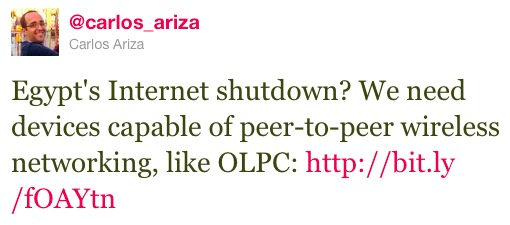With the Egyptian government blocking Internet access during the current protests, people are thinking of ways that different technologies could work around this digital blockade. A few have thought to point out that the peer-to-peer wireless mesh networking of the XO laptop from OLPC could be used to route around a government's Internet ban.

The current XO mesh networking could not support Egypt's 83 million people. The XO mesh network can't really even support a classroom of students, let alone the 13 million current Internet users in Egypt. After approximately 25 connections, the mesh is overwhelmed with packet collision and loss.
See, each mesh hop adds propagation delay and multiplies radio traffic and congestion, reducing performance and when the density gets high enough, the system simply breaks down. In fact, the mesh networking became such an issue that the XO-1.5 doesn't support mesh networking anymore, only ad hoc networks.
Now a real scalable mesh networking solution is available that could link disparate computer users to an Internet uplink, provided one existed - that would be FunkFeuer Free Net.


Anything for better communications in a terrible situation, but the last time I recall a mesh network test it was difficult to establish and use even under peaceful circumstances...
Admittedly that test was in 2008; perhaps it is more stable now...
Just because you don't have an active internet connection doesn't mean you can't have your own LAN. That's where the XS side of the OLPC project would come in. Setup is relatively simple compared to "regular" Linux server installs, the XS's dhcp range is huge, Apache is included, and it'll run on really basic hardware, even the XO itself. Any wifi enabled device, even a Kindle, can connect.
Set up an XS, connect it to an access point, and have other folks in range set up their APs as repeaters. Instead of relying on Twitter, set up Statusnet on the XS and folks can communicate in a similar fashion. Of course, it can't get out to the outside world without being connected to the internet, but it would do for local coordination and dissemination of news.
Say the XS admin is in contact with a ham radio operator. He/she can get the latest news and throw it on the XS's Apache server. And if there's a dialup connection, you can download content to be hosted locally over the LAN. It would take running around with USB drives, but "sneakernet" has always been part of the OLPC idea.
This paradigm is long standing on OLPC's XS side, where deployments might not have reliable connections or any at all. Even without "The Internet," if you're creative enough you can find ways to share content and communicate. And I haven't even gotten to Jabber yet. You can connect to the XS's Jabber server with any XMPP client and have real time communication as long as you're in range of the LAN.
As far as messages getting out, a simple flat text guestbook hosted on the XS could be uploaded over dialup to the rest of the world.
Who has a Ham radio these days in Egypt?
I think that a few clarifications are needed about OLPC's mesh network.
First of all, it is yet another WiFi mesh implementation. There were many before it and there would be a few after it (its evolution, open80211s has been in the linux kernel for quite some time now).
Given its multihop nature, it is especially ill-suited to replace plain WiFi in classroom environments because the added control traffic will saturate the available spectrum much faster than "normal" (infrastructure) WiFi.
It is meant to provide ad-hoc connectivity when laptops are dispersed in neighborhoods, apartment buildings etc where it can be used to share an internet connection or run p2p applications.
Comparing XO-1 mesh with the OLSR implementation that FunkFeuer is using is like comparing trains to automobiles. They both move people around but in different ways.
Now as to why OLPC abandoned the mesh in XO 1.5, it had very little to do with its utility (pretty limited since the software team decided to disable internet sharing in favor of its XS) and everything to do with the lack of engineering resources required to port the embedded mesh code to the new wifi chip as well as the availability of open80211s (which requires much less engineering effort to run - yet to be completed though...)